MGT723 Research Report: Diversity Management in Public Sector Services
VerifiedAdded on 2023/06/07
|9
|2001
|176
Report
AI Summary
This research report investigates the relationship between diversity management practices and carbon emission reduction strategies within the public sector, focusing on the influence of organizational incentives and transformational leadership. The study utilizes survey data from various companies, employing structural equation modeling to test the hypothesis regarding the impact of incentives on carbon emission levels. The findings reveal that different companies employ diverse approaches to carbon emission management, largely influenced by their organizational culture and the presence of incentives. The analysis further explores the impact of these incentives across industries such as forestry and air freight transportation, providing descriptive and inferential statistical analyses to compare carbon emission changes. The report concludes with a discussion on the implications of these findings, highlighting the importance of understanding the role of leadership and the need for tailored strategies to promote effective carbon emission reduction within the public sector.
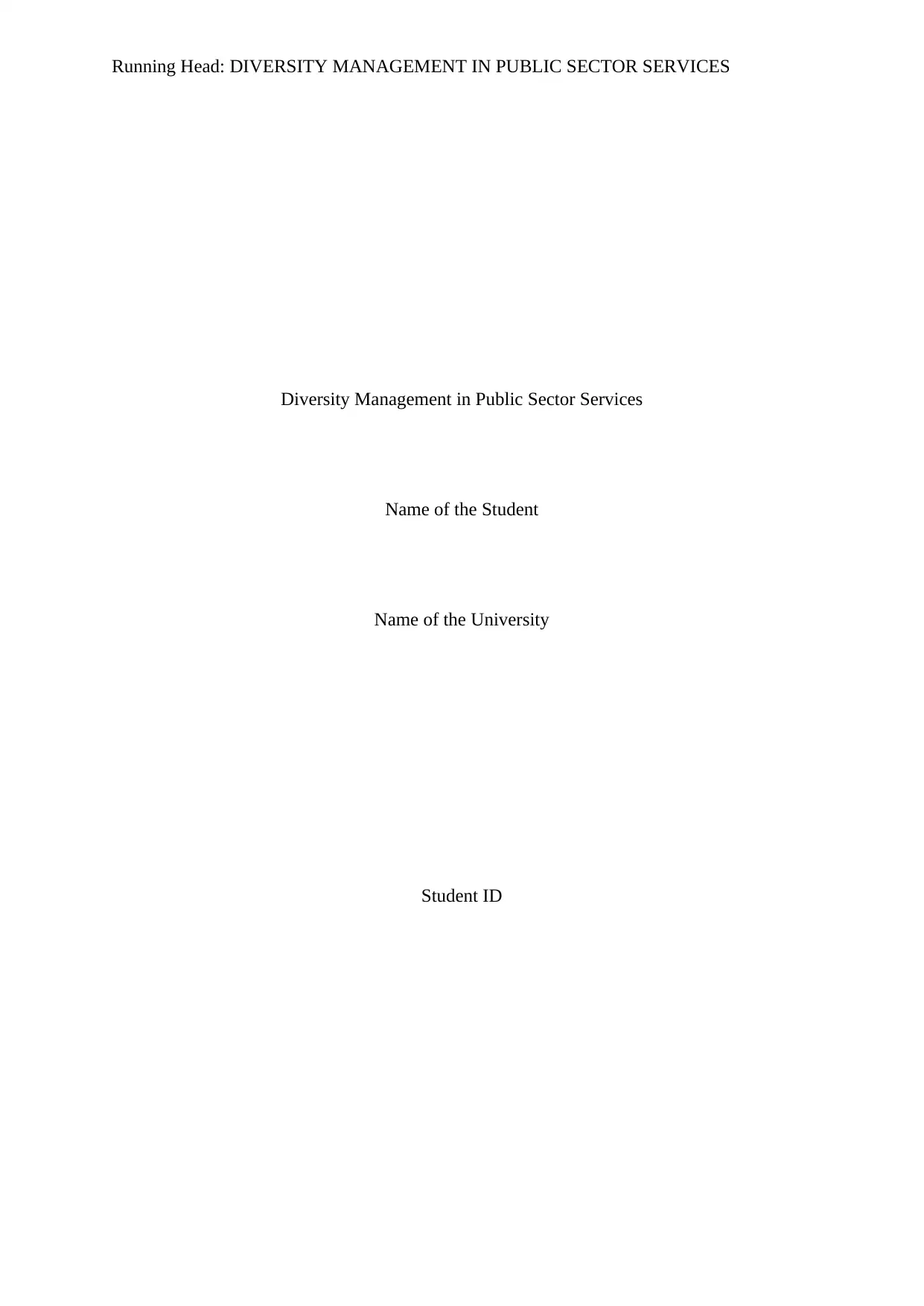
Running Head: DIVERSITY MANAGEMENT IN PUBLIC SECTOR SERVICES
Diversity Management in Public Sector Services
Name of the Student
Name of the University
Student ID
Diversity Management in Public Sector Services
Name of the Student
Name of the University
Student ID
Paraphrase This Document
Need a fresh take? Get an instant paraphrase of this document with our AI Paraphraser
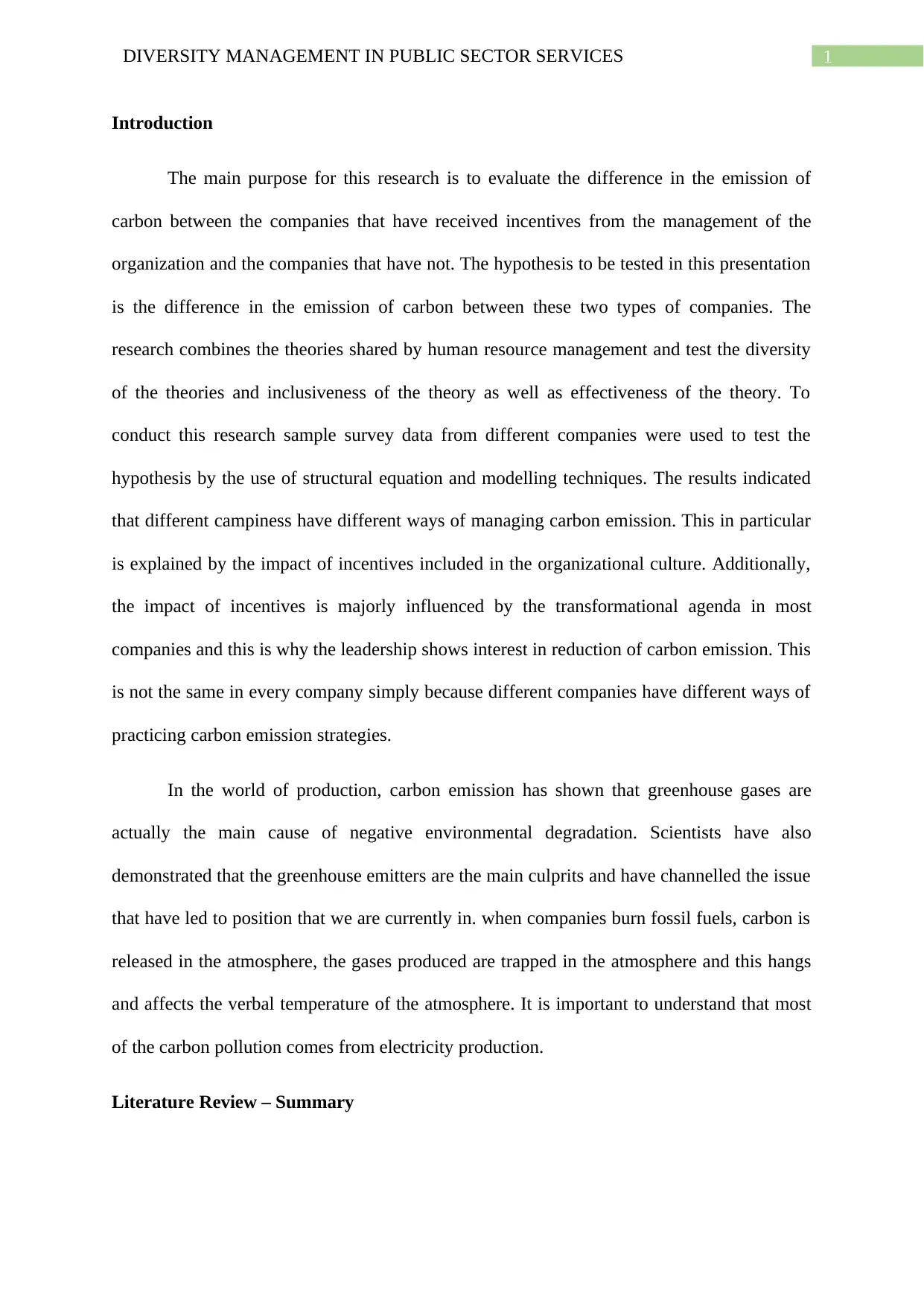
1DIVERSITY MANAGEMENT IN PUBLIC SECTOR SERVICES
Introduction
The main purpose for this research is to evaluate the difference in the emission of
carbon between the companies that have received incentives from the management of the
organization and the companies that have not. The hypothesis to be tested in this presentation
is the difference in the emission of carbon between these two types of companies. The
research combines the theories shared by human resource management and test the diversity
of the theories and inclusiveness of the theory as well as effectiveness of the theory. To
conduct this research sample survey data from different companies were used to test the
hypothesis by the use of structural equation and modelling techniques. The results indicated
that different campiness have different ways of managing carbon emission. This in particular
is explained by the impact of incentives included in the organizational culture. Additionally,
the impact of incentives is majorly influenced by the transformational agenda in most
companies and this is why the leadership shows interest in reduction of carbon emission. This
is not the same in every company simply because different companies have different ways of
practicing carbon emission strategies.
In the world of production, carbon emission has shown that greenhouse gases are
actually the main cause of negative environmental degradation. Scientists have also
demonstrated that the greenhouse emitters are the main culprits and have channelled the issue
that have led to position that we are currently in. when companies burn fossil fuels, carbon is
released in the atmosphere, the gases produced are trapped in the atmosphere and this hangs
and affects the verbal temperature of the atmosphere. It is important to understand that most
of the carbon pollution comes from electricity production.
Literature Review – Summary
Introduction
The main purpose for this research is to evaluate the difference in the emission of
carbon between the companies that have received incentives from the management of the
organization and the companies that have not. The hypothesis to be tested in this presentation
is the difference in the emission of carbon between these two types of companies. The
research combines the theories shared by human resource management and test the diversity
of the theories and inclusiveness of the theory as well as effectiveness of the theory. To
conduct this research sample survey data from different companies were used to test the
hypothesis by the use of structural equation and modelling techniques. The results indicated
that different campiness have different ways of managing carbon emission. This in particular
is explained by the impact of incentives included in the organizational culture. Additionally,
the impact of incentives is majorly influenced by the transformational agenda in most
companies and this is why the leadership shows interest in reduction of carbon emission. This
is not the same in every company simply because different companies have different ways of
practicing carbon emission strategies.
In the world of production, carbon emission has shown that greenhouse gases are
actually the main cause of negative environmental degradation. Scientists have also
demonstrated that the greenhouse emitters are the main culprits and have channelled the issue
that have led to position that we are currently in. when companies burn fossil fuels, carbon is
released in the atmosphere, the gases produced are trapped in the atmosphere and this hangs
and affects the verbal temperature of the atmosphere. It is important to understand that most
of the carbon pollution comes from electricity production.
Literature Review – Summary
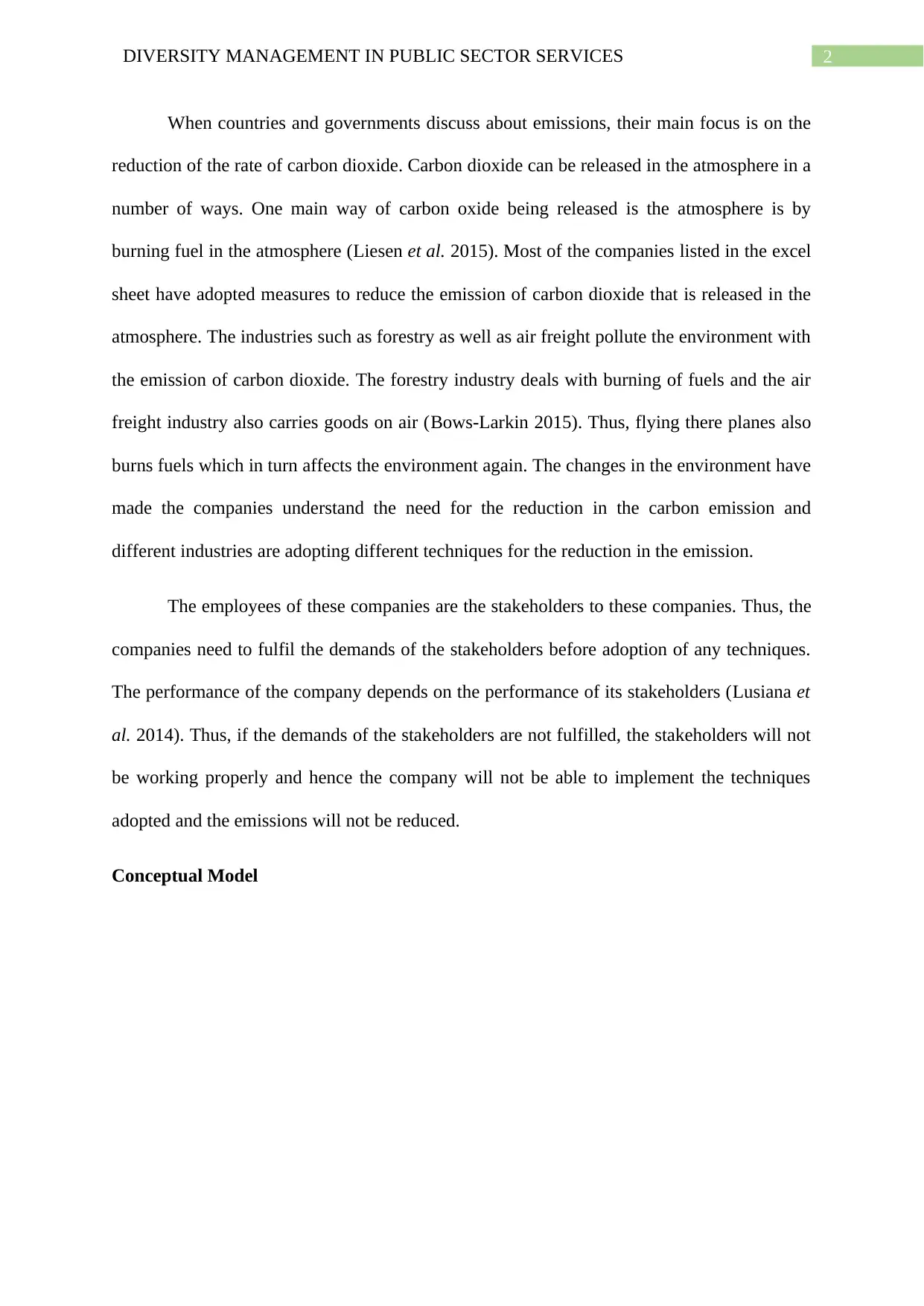
2DIVERSITY MANAGEMENT IN PUBLIC SECTOR SERVICES
When countries and governments discuss about emissions, their main focus is on the
reduction of the rate of carbon dioxide. Carbon dioxide can be released in the atmosphere in a
number of ways. One main way of carbon oxide being released is the atmosphere is by
burning fuel in the atmosphere (Liesen et al. 2015). Most of the companies listed in the excel
sheet have adopted measures to reduce the emission of carbon dioxide that is released in the
atmosphere. The industries such as forestry as well as air freight pollute the environment with
the emission of carbon dioxide. The forestry industry deals with burning of fuels and the air
freight industry also carries goods on air (Bows-Larkin 2015). Thus, flying there planes also
burns fuels which in turn affects the environment again. The changes in the environment have
made the companies understand the need for the reduction in the carbon emission and
different industries are adopting different techniques for the reduction in the emission.
The employees of these companies are the stakeholders to these companies. Thus, the
companies need to fulfil the demands of the stakeholders before adoption of any techniques.
The performance of the company depends on the performance of its stakeholders (Lusiana et
al. 2014). Thus, if the demands of the stakeholders are not fulfilled, the stakeholders will not
be working properly and hence the company will not be able to implement the techniques
adopted and the emissions will not be reduced.
Conceptual Model
When countries and governments discuss about emissions, their main focus is on the
reduction of the rate of carbon dioxide. Carbon dioxide can be released in the atmosphere in a
number of ways. One main way of carbon oxide being released is the atmosphere is by
burning fuel in the atmosphere (Liesen et al. 2015). Most of the companies listed in the excel
sheet have adopted measures to reduce the emission of carbon dioxide that is released in the
atmosphere. The industries such as forestry as well as air freight pollute the environment with
the emission of carbon dioxide. The forestry industry deals with burning of fuels and the air
freight industry also carries goods on air (Bows-Larkin 2015). Thus, flying there planes also
burns fuels which in turn affects the environment again. The changes in the environment have
made the companies understand the need for the reduction in the carbon emission and
different industries are adopting different techniques for the reduction in the emission.
The employees of these companies are the stakeholders to these companies. Thus, the
companies need to fulfil the demands of the stakeholders before adoption of any techniques.
The performance of the company depends on the performance of its stakeholders (Lusiana et
al. 2014). Thus, if the demands of the stakeholders are not fulfilled, the stakeholders will not
be working properly and hence the company will not be able to implement the techniques
adopted and the emissions will not be reduced.
Conceptual Model
⊘ This is a preview!⊘
Do you want full access?
Subscribe today to unlock all pages.

Trusted by 1+ million students worldwide
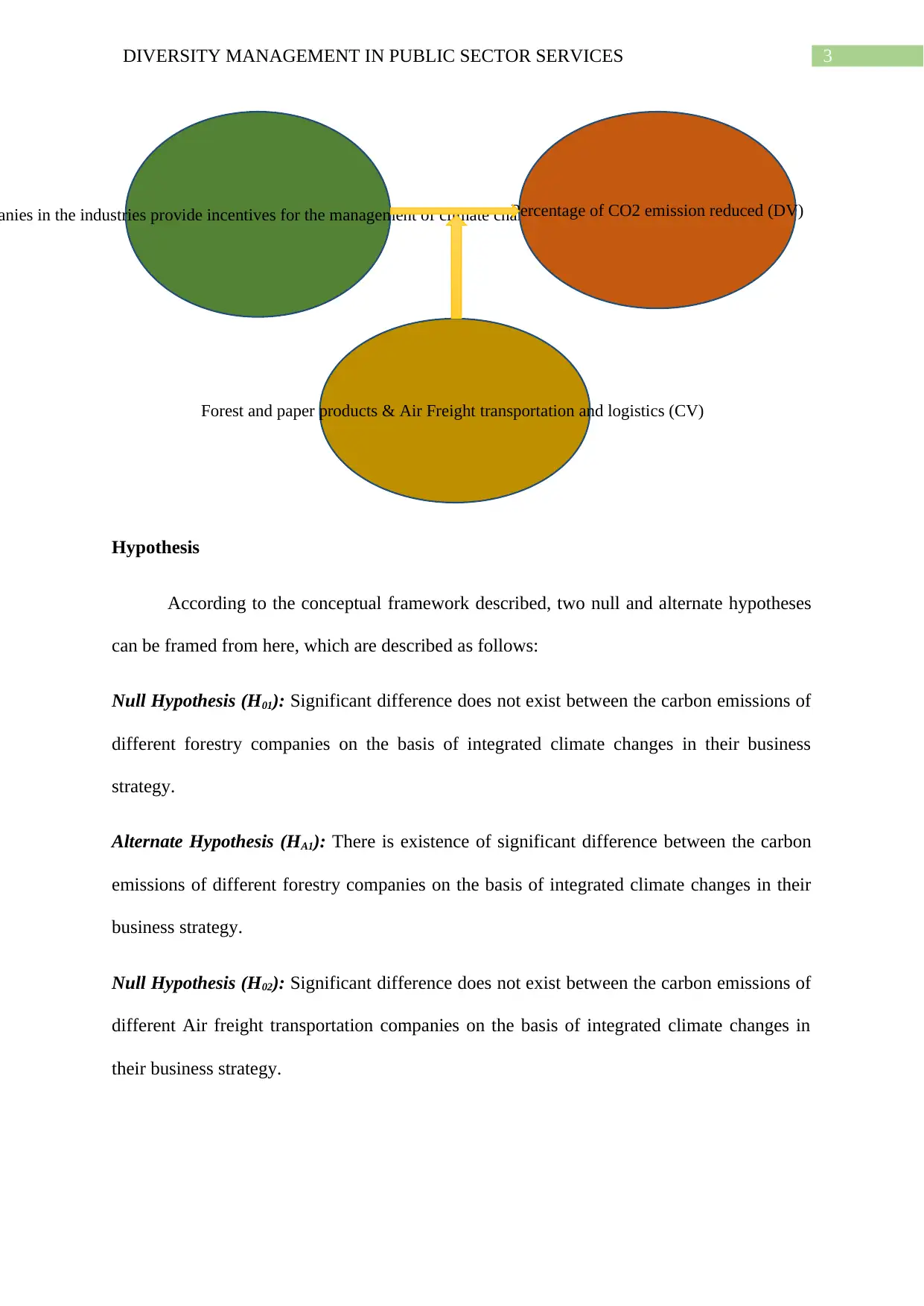
anies in the industries provide incentives for the management of climate change. (IV)Percentage of CO2 emission reduced (DV)
Forest and paper products & Air Freight transportation and logistics (CV)
3DIVERSITY MANAGEMENT IN PUBLIC SECTOR SERVICES
Hypothesis
According to the conceptual framework described, two null and alternate hypotheses
can be framed from here, which are described as follows:
Null Hypothesis (H01): Significant difference does not exist between the carbon emissions of
different forestry companies on the basis of integrated climate changes in their business
strategy.
Alternate Hypothesis (HA1): There is existence of significant difference between the carbon
emissions of different forestry companies on the basis of integrated climate changes in their
business strategy.
Null Hypothesis (H02): Significant difference does not exist between the carbon emissions of
different Air freight transportation companies on the basis of integrated climate changes in
their business strategy.
Forest and paper products & Air Freight transportation and logistics (CV)
3DIVERSITY MANAGEMENT IN PUBLIC SECTOR SERVICES
Hypothesis
According to the conceptual framework described, two null and alternate hypotheses
can be framed from here, which are described as follows:
Null Hypothesis (H01): Significant difference does not exist between the carbon emissions of
different forestry companies on the basis of integrated climate changes in their business
strategy.
Alternate Hypothesis (HA1): There is existence of significant difference between the carbon
emissions of different forestry companies on the basis of integrated climate changes in their
business strategy.
Null Hypothesis (H02): Significant difference does not exist between the carbon emissions of
different Air freight transportation companies on the basis of integrated climate changes in
their business strategy.
Paraphrase This Document
Need a fresh take? Get an instant paraphrase of this document with our AI Paraphraser
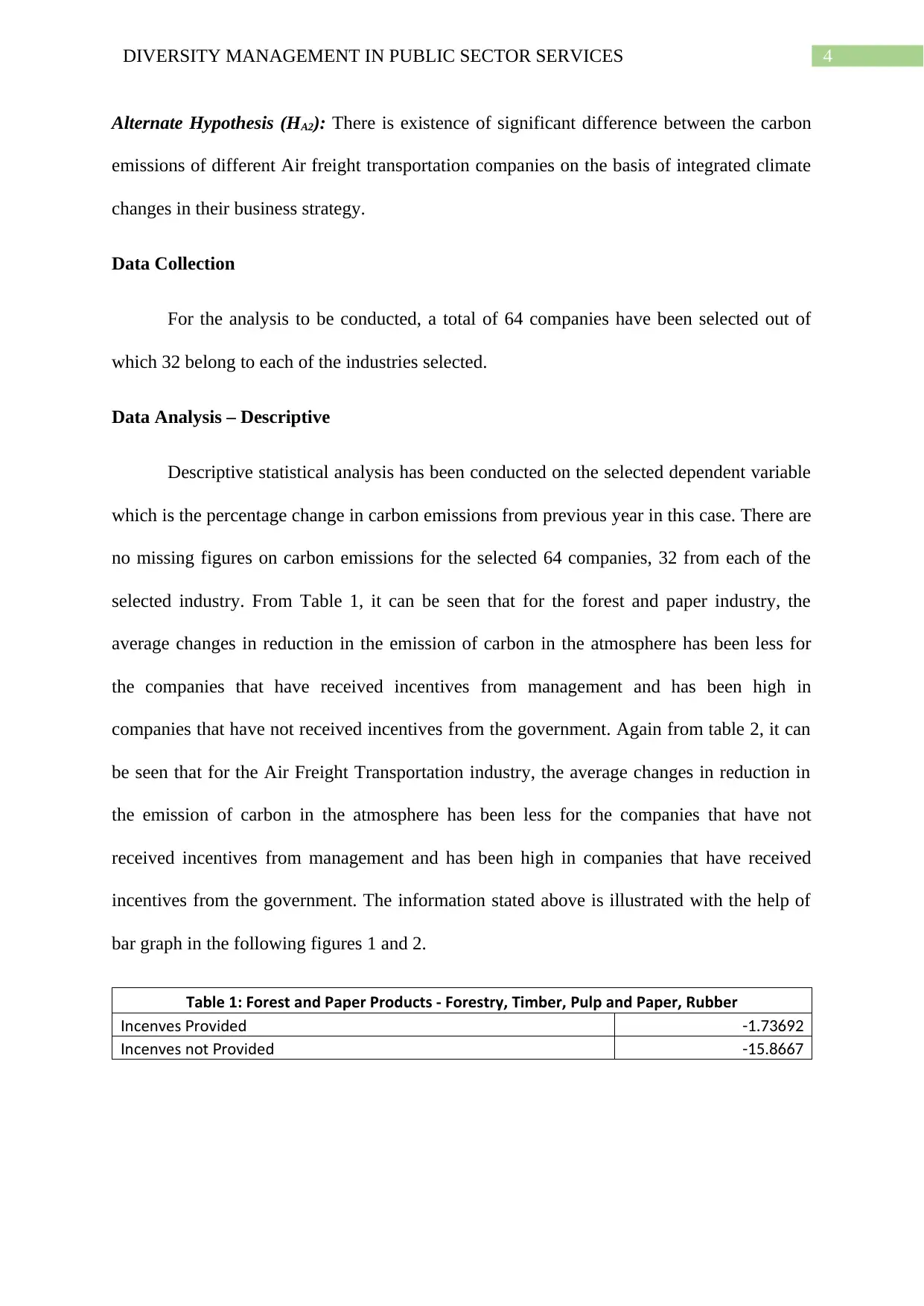
4DIVERSITY MANAGEMENT IN PUBLIC SECTOR SERVICES
Alternate Hypothesis (HA2): There is existence of significant difference between the carbon
emissions of different Air freight transportation companies on the basis of integrated climate
changes in their business strategy.
Data Collection
For the analysis to be conducted, a total of 64 companies have been selected out of
which 32 belong to each of the industries selected.
Data Analysis – Descriptive
Descriptive statistical analysis has been conducted on the selected dependent variable
which is the percentage change in carbon emissions from previous year in this case. There are
no missing figures on carbon emissions for the selected 64 companies, 32 from each of the
selected industry. From Table 1, it can be seen that for the forest and paper industry, the
average changes in reduction in the emission of carbon in the atmosphere has been less for
the companies that have received incentives from management and has been high in
companies that have not received incentives from the government. Again from table 2, it can
be seen that for the Air Freight Transportation industry, the average changes in reduction in
the emission of carbon in the atmosphere has been less for the companies that have not
received incentives from management and has been high in companies that have received
incentives from the government. The information stated above is illustrated with the help of
bar graph in the following figures 1 and 2.
Table 1: Forest and Paper Products - Forestry, Timber, Pulp and Paper, Rubber
ncentives rovidedI P -1.73692
ncentives not rovidedI P -15.8667
Alternate Hypothesis (HA2): There is existence of significant difference between the carbon
emissions of different Air freight transportation companies on the basis of integrated climate
changes in their business strategy.
Data Collection
For the analysis to be conducted, a total of 64 companies have been selected out of
which 32 belong to each of the industries selected.
Data Analysis – Descriptive
Descriptive statistical analysis has been conducted on the selected dependent variable
which is the percentage change in carbon emissions from previous year in this case. There are
no missing figures on carbon emissions for the selected 64 companies, 32 from each of the
selected industry. From Table 1, it can be seen that for the forest and paper industry, the
average changes in reduction in the emission of carbon in the atmosphere has been less for
the companies that have received incentives from management and has been high in
companies that have not received incentives from the government. Again from table 2, it can
be seen that for the Air Freight Transportation industry, the average changes in reduction in
the emission of carbon in the atmosphere has been less for the companies that have not
received incentives from management and has been high in companies that have received
incentives from the government. The information stated above is illustrated with the help of
bar graph in the following figures 1 and 2.
Table 1: Forest and Paper Products - Forestry, Timber, Pulp and Paper, Rubber
ncentives rovidedI P -1.73692
ncentives not rovidedI P -15.8667
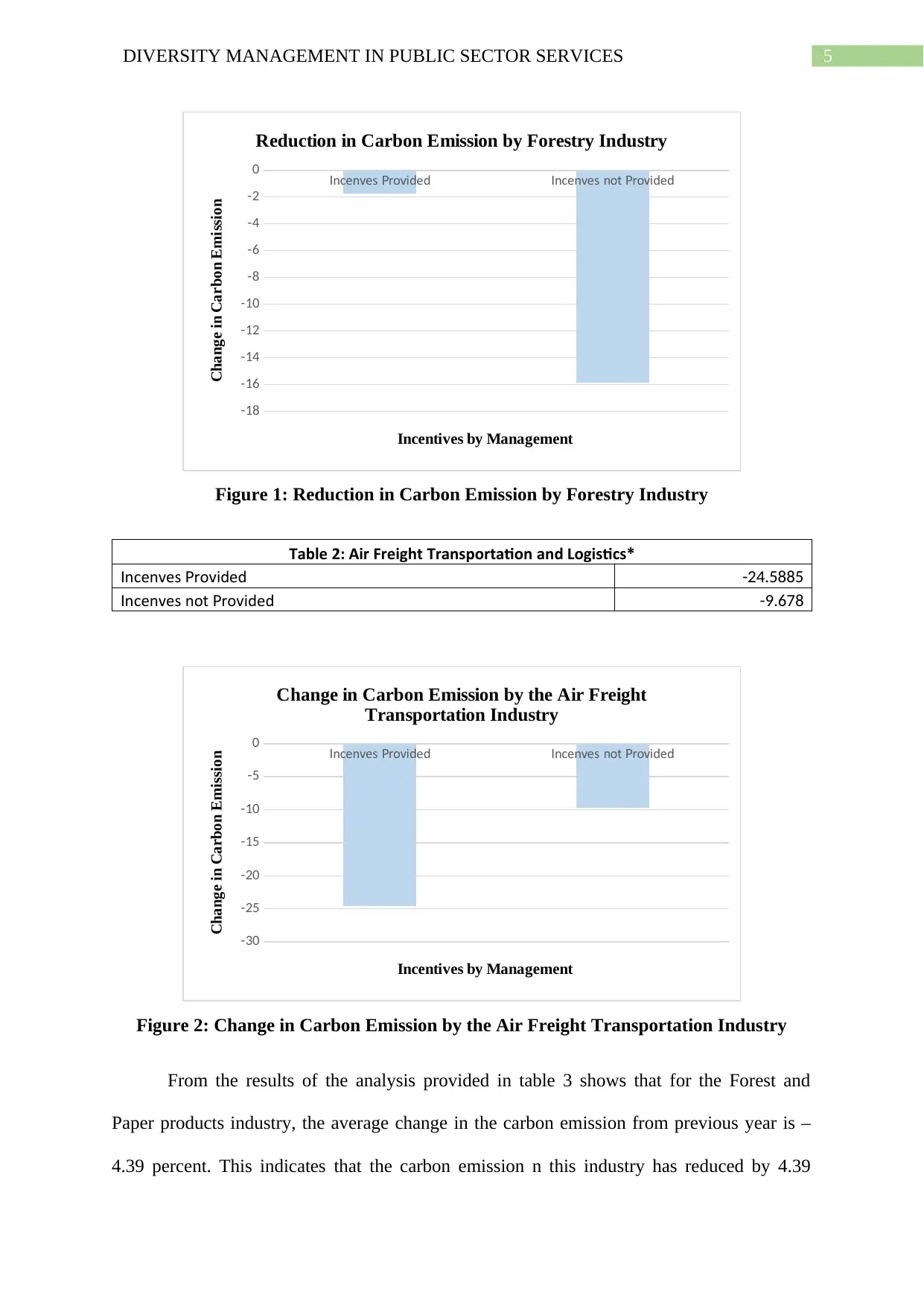
5DIVERSITY MANAGEMENT IN PUBLIC SECTOR SERVICES
ncentives rovidedI P ncentives not rovidedI P
-18
-16
-14
-12
-10
-8
-6
-4
-2
0
Reduction in Carbon Emission by Forestry Industry
Incentives by Management
Change in Carbon Emission
Figure 1: Reduction in Carbon Emission by Forestry Industry
Table 2: Air Freight Transportation and Logistics*
ncentives rovidedI P -24.5885
ncentives not rovidedI P -9.678
ncentives rovidedI P ncentives not rovidedI P
-30
-25
-20
-15
-10
-5
0
Change in Carbon Emission by the Air Freight
Transportation Industry
Incentives by Management
Change in Carbon Emission
Figure 2: Change in Carbon Emission by the Air Freight Transportation Industry
From the results of the analysis provided in table 3 shows that for the Forest and
Paper products industry, the average change in the carbon emission from previous year is –
4.39 percent. This indicates that the carbon emission n this industry has reduced by 4.39
ncentives rovidedI P ncentives not rovidedI P
-18
-16
-14
-12
-10
-8
-6
-4
-2
0
Reduction in Carbon Emission by Forestry Industry
Incentives by Management
Change in Carbon Emission
Figure 1: Reduction in Carbon Emission by Forestry Industry
Table 2: Air Freight Transportation and Logistics*
ncentives rovidedI P -24.5885
ncentives not rovidedI P -9.678
ncentives rovidedI P ncentives not rovidedI P
-30
-25
-20
-15
-10
-5
0
Change in Carbon Emission by the Air Freight
Transportation Industry
Incentives by Management
Change in Carbon Emission
Figure 2: Change in Carbon Emission by the Air Freight Transportation Industry
From the results of the analysis provided in table 3 shows that for the Forest and
Paper products industry, the average change in the carbon emission from previous year is –
4.39 percent. This indicates that the carbon emission n this industry has reduced by 4.39
⊘ This is a preview!⊘
Do you want full access?
Subscribe today to unlock all pages.

Trusted by 1+ million students worldwide
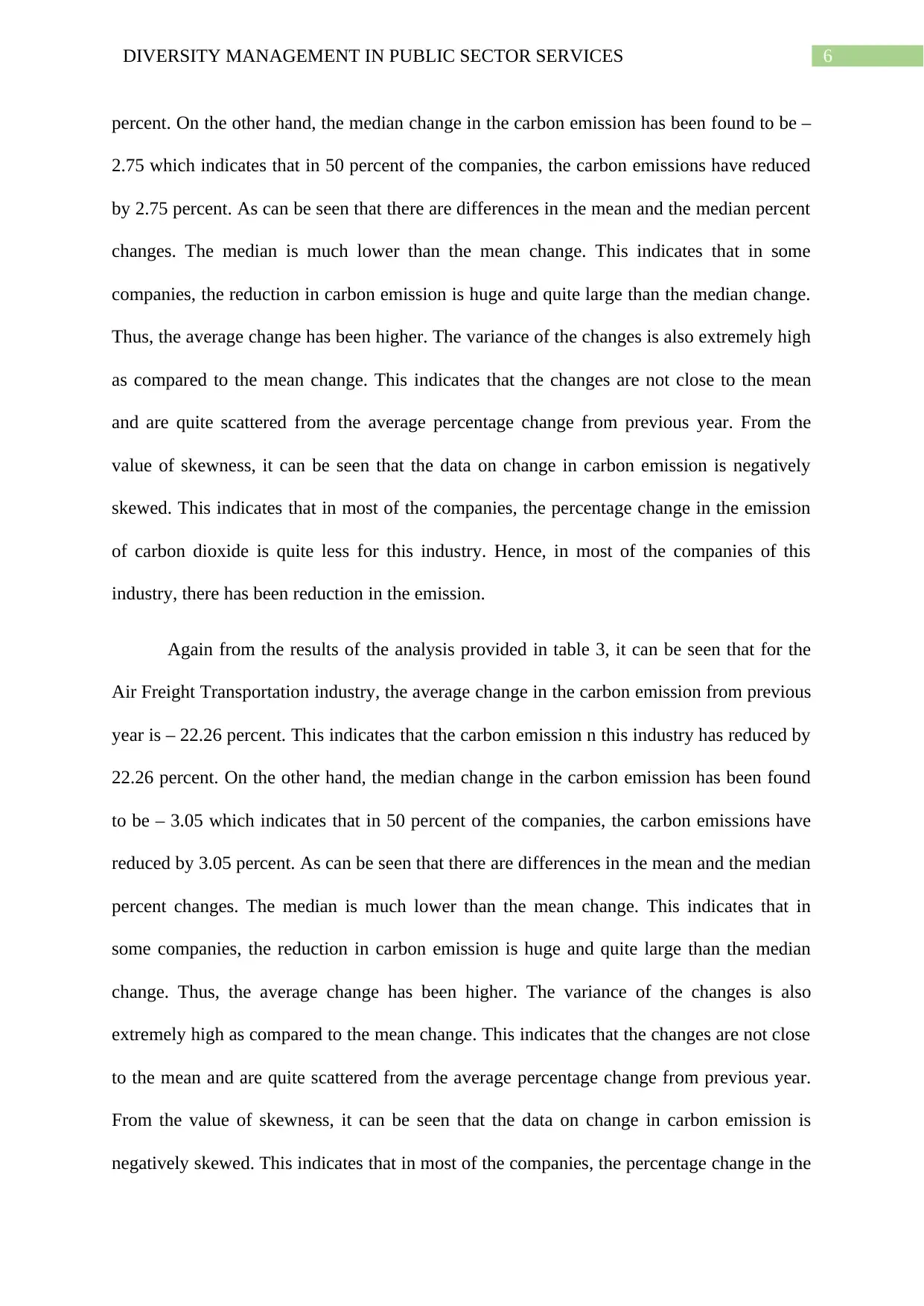
6DIVERSITY MANAGEMENT IN PUBLIC SECTOR SERVICES
percent. On the other hand, the median change in the carbon emission has been found to be –
2.75 which indicates that in 50 percent of the companies, the carbon emissions have reduced
by 2.75 percent. As can be seen that there are differences in the mean and the median percent
changes. The median is much lower than the mean change. This indicates that in some
companies, the reduction in carbon emission is huge and quite large than the median change.
Thus, the average change has been higher. The variance of the changes is also extremely high
as compared to the mean change. This indicates that the changes are not close to the mean
and are quite scattered from the average percentage change from previous year. From the
value of skewness, it can be seen that the data on change in carbon emission is negatively
skewed. This indicates that in most of the companies, the percentage change in the emission
of carbon dioxide is quite less for this industry. Hence, in most of the companies of this
industry, there has been reduction in the emission.
Again from the results of the analysis provided in table 3, it can be seen that for the
Air Freight Transportation industry, the average change in the carbon emission from previous
year is – 22.26 percent. This indicates that the carbon emission n this industry has reduced by
22.26 percent. On the other hand, the median change in the carbon emission has been found
to be – 3.05 which indicates that in 50 percent of the companies, the carbon emissions have
reduced by 3.05 percent. As can be seen that there are differences in the mean and the median
percent changes. The median is much lower than the mean change. This indicates that in
some companies, the reduction in carbon emission is huge and quite large than the median
change. Thus, the average change has been higher. The variance of the changes is also
extremely high as compared to the mean change. This indicates that the changes are not close
to the mean and are quite scattered from the average percentage change from previous year.
From the value of skewness, it can be seen that the data on change in carbon emission is
negatively skewed. This indicates that in most of the companies, the percentage change in the
percent. On the other hand, the median change in the carbon emission has been found to be –
2.75 which indicates that in 50 percent of the companies, the carbon emissions have reduced
by 2.75 percent. As can be seen that there are differences in the mean and the median percent
changes. The median is much lower than the mean change. This indicates that in some
companies, the reduction in carbon emission is huge and quite large than the median change.
Thus, the average change has been higher. The variance of the changes is also extremely high
as compared to the mean change. This indicates that the changes are not close to the mean
and are quite scattered from the average percentage change from previous year. From the
value of skewness, it can be seen that the data on change in carbon emission is negatively
skewed. This indicates that in most of the companies, the percentage change in the emission
of carbon dioxide is quite less for this industry. Hence, in most of the companies of this
industry, there has been reduction in the emission.
Again from the results of the analysis provided in table 3, it can be seen that for the
Air Freight Transportation industry, the average change in the carbon emission from previous
year is – 22.26 percent. This indicates that the carbon emission n this industry has reduced by
22.26 percent. On the other hand, the median change in the carbon emission has been found
to be – 3.05 which indicates that in 50 percent of the companies, the carbon emissions have
reduced by 3.05 percent. As can be seen that there are differences in the mean and the median
percent changes. The median is much lower than the mean change. This indicates that in
some companies, the reduction in carbon emission is huge and quite large than the median
change. Thus, the average change has been higher. The variance of the changes is also
extremely high as compared to the mean change. This indicates that the changes are not close
to the mean and are quite scattered from the average percentage change from previous year.
From the value of skewness, it can be seen that the data on change in carbon emission is
negatively skewed. This indicates that in most of the companies, the percentage change in the
Paraphrase This Document
Need a fresh take? Get an instant paraphrase of this document with our AI Paraphraser
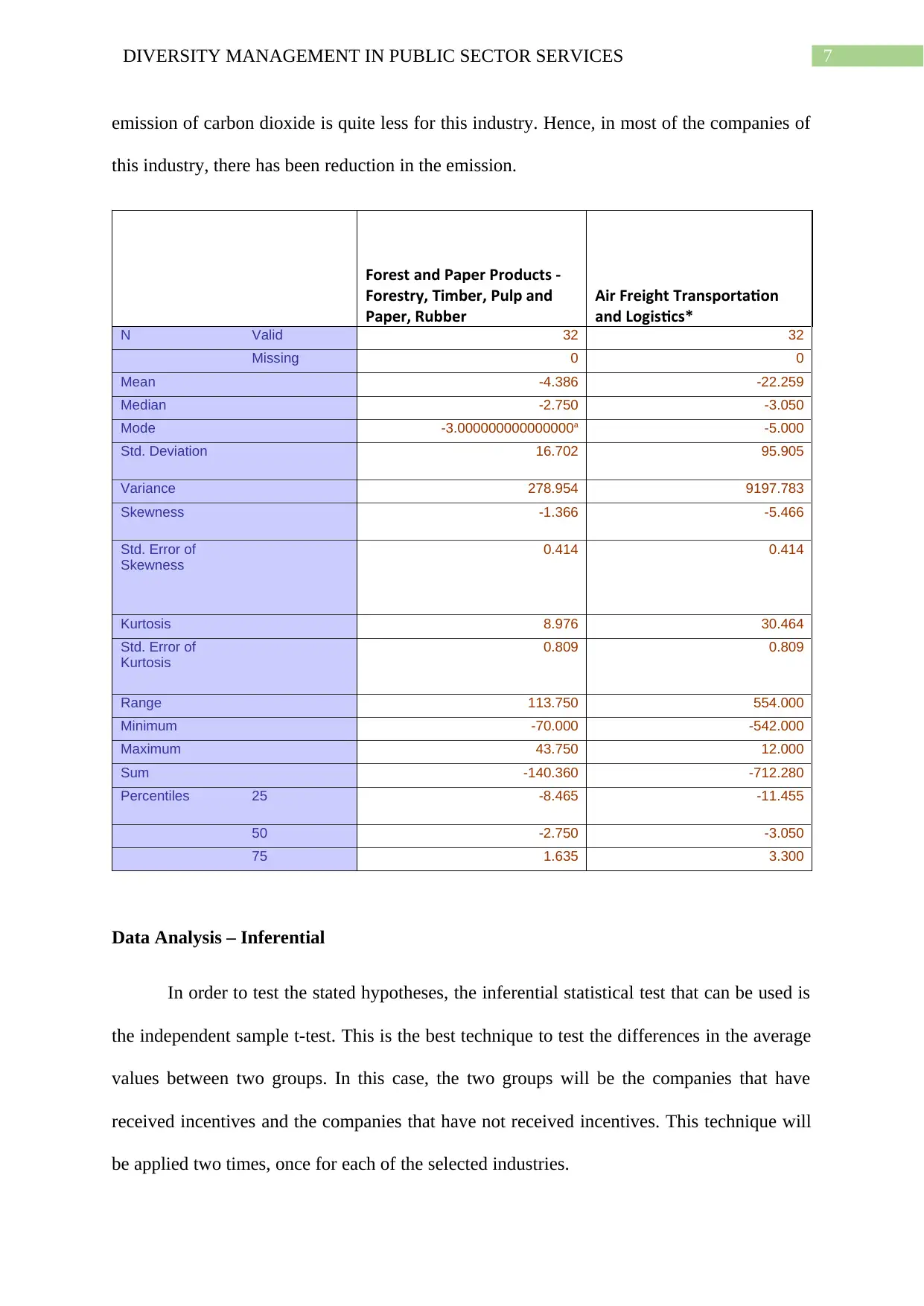
7DIVERSITY MANAGEMENT IN PUBLIC SECTOR SERVICES
emission of carbon dioxide is quite less for this industry. Hence, in most of the companies of
this industry, there has been reduction in the emission.
Forest and Paper Products -
Forestry, Timber, Pulp and
Paper, Rubber
Air Freight Transportation
and Logistics*
N Valid 32 32
Missing 0 0
Mean -4.386 -22.259
Median -2.750 -3.050
Mode -3.000000000000000a -5.000
Std. Deviation 16.702 95.905
Variance 278.954 9197.783
Skewness -1.366 -5.466
Std. Error of
Skewness
0.414 0.414
Kurtosis 8.976 30.464
Std. Error of
Kurtosis
0.809 0.809
Range 113.750 554.000
Minimum -70.000 -542.000
Maximum 43.750 12.000
Sum -140.360 -712.280
Percentiles 25 -8.465 -11.455
50 -2.750 -3.050
75 1.635 3.300
Data Analysis – Inferential
In order to test the stated hypotheses, the inferential statistical test that can be used is
the independent sample t-test. This is the best technique to test the differences in the average
values between two groups. In this case, the two groups will be the companies that have
received incentives and the companies that have not received incentives. This technique will
be applied two times, once for each of the selected industries.
emission of carbon dioxide is quite less for this industry. Hence, in most of the companies of
this industry, there has been reduction in the emission.
Forest and Paper Products -
Forestry, Timber, Pulp and
Paper, Rubber
Air Freight Transportation
and Logistics*
N Valid 32 32
Missing 0 0
Mean -4.386 -22.259
Median -2.750 -3.050
Mode -3.000000000000000a -5.000
Std. Deviation 16.702 95.905
Variance 278.954 9197.783
Skewness -1.366 -5.466
Std. Error of
Skewness
0.414 0.414
Kurtosis 8.976 30.464
Std. Error of
Kurtosis
0.809 0.809
Range 113.750 554.000
Minimum -70.000 -542.000
Maximum 43.750 12.000
Sum -140.360 -712.280
Percentiles 25 -8.465 -11.455
50 -2.750 -3.050
75 1.635 3.300
Data Analysis – Inferential
In order to test the stated hypotheses, the inferential statistical test that can be used is
the independent sample t-test. This is the best technique to test the differences in the average
values between two groups. In this case, the two groups will be the companies that have
received incentives and the companies that have not received incentives. This technique will
be applied two times, once for each of the selected industries.
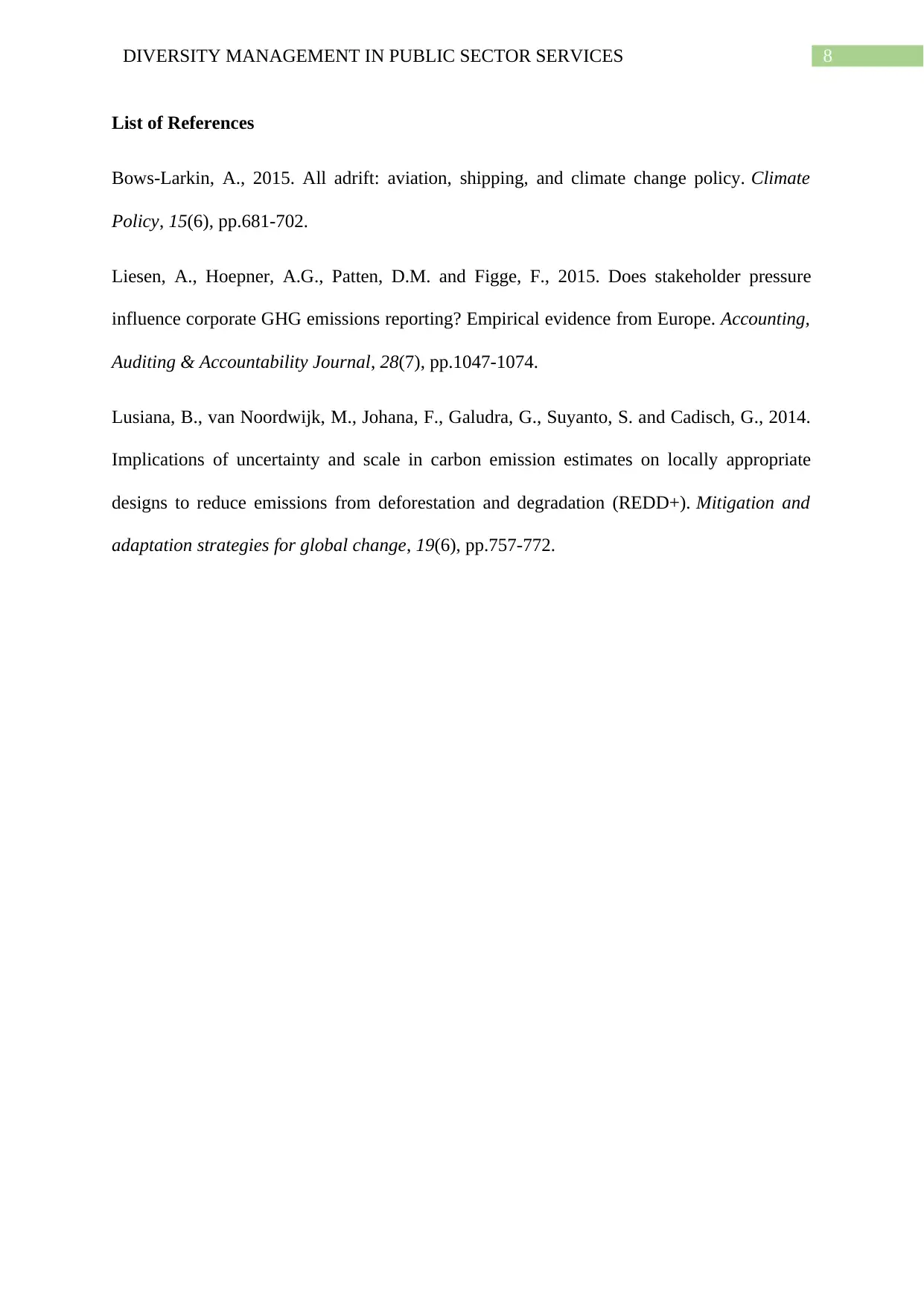
8DIVERSITY MANAGEMENT IN PUBLIC SECTOR SERVICES
List of References
Bows-Larkin, A., 2015. All adrift: aviation, shipping, and climate change policy. Climate
Policy, 15(6), pp.681-702.
Liesen, A., Hoepner, A.G., Patten, D.M. and Figge, F., 2015. Does stakeholder pressure
influence corporate GHG emissions reporting? Empirical evidence from Europe. Accounting,
Auditing & Accountability Journal, 28(7), pp.1047-1074.
Lusiana, B., van Noordwijk, M., Johana, F., Galudra, G., Suyanto, S. and Cadisch, G., 2014.
Implications of uncertainty and scale in carbon emission estimates on locally appropriate
designs to reduce emissions from deforestation and degradation (REDD+). Mitigation and
adaptation strategies for global change, 19(6), pp.757-772.
List of References
Bows-Larkin, A., 2015. All adrift: aviation, shipping, and climate change policy. Climate
Policy, 15(6), pp.681-702.
Liesen, A., Hoepner, A.G., Patten, D.M. and Figge, F., 2015. Does stakeholder pressure
influence corporate GHG emissions reporting? Empirical evidence from Europe. Accounting,
Auditing & Accountability Journal, 28(7), pp.1047-1074.
Lusiana, B., van Noordwijk, M., Johana, F., Galudra, G., Suyanto, S. and Cadisch, G., 2014.
Implications of uncertainty and scale in carbon emission estimates on locally appropriate
designs to reduce emissions from deforestation and degradation (REDD+). Mitigation and
adaptation strategies for global change, 19(6), pp.757-772.
⊘ This is a preview!⊘
Do you want full access?
Subscribe today to unlock all pages.

Trusted by 1+ million students worldwide
1 out of 9
Related Documents
Your All-in-One AI-Powered Toolkit for Academic Success.
+13062052269
info@desklib.com
Available 24*7 on WhatsApp / Email
![[object Object]](/_next/static/media/star-bottom.7253800d.svg)
Unlock your academic potential
Copyright © 2020–2025 A2Z Services. All Rights Reserved. Developed and managed by ZUCOL.




